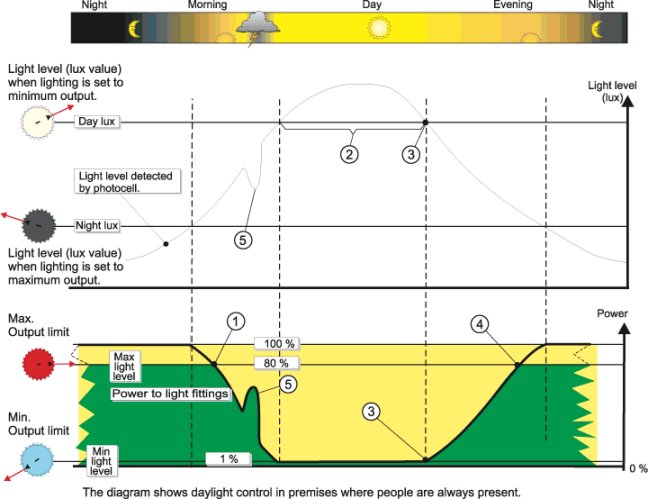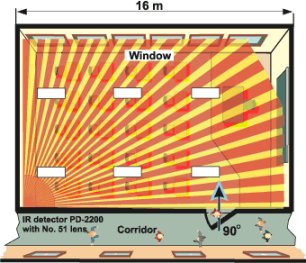3E. Classroom/conference room with passive IR detection
Premises with a single lighting group, automatic lighting control and manual dimming
| Premises
In classrooms (or conference rooms) it should be possible to switch on lighting when required (classroom has natural light from windows) and switch off lighting when the premises are empty. When special activities take place it should be possible to dim the lighting manually to the required level. It would be an infringement of personal freedom to set a light level that cannot be changed. Different people have different lighting needs for different activities. NV-3TR provides the possibility to regulate the light level manually. The premises have large windows and let in a large amount of natural light. A dynamic daylight-dependent lighting system is therefore installed. This allows the lighting level to adjust automatically to suit the natural light and the way that the premises are used. When presence is detected, the lighting level is increased gradually from the base lighting level of around one per cent to a level that is determined by the amount of natural light entering the room. Light sources The light fittings have dimmable HF ballasts with analogue control (1–10 V). Detector placement In schoolrooms and conference rooms IR detection is combined with lens no. 51. This gives the maximum possible resolution and hence the ability to detect small movements. The placement of the detector is critical to performance! The illustration below shows how the detector should be positioned. When combined with lens no. 51, which permits higher installation, this enables optimum detection on entry. In addition, the detector cannot see out through the door, which means that the lighting does not remain switched on when people pass by in the corridor outside. Placing the detector in the corner that is furthest from the door allows the detector to be installed higher up, which reduces the risk of tampering. When installed in this way the slightly down-tilted detection fields reach the door at the correct height. The detector fields can be tilted downwards by sliding the circuit upwards in the detector. Information for current budget
|
Control system
To exploit the hidden savings potential available in all areas that have natural lighting, the installation should include an on/off logic module that prevents the lighting from being switched on when someone enters. All activities may not require artificial lighting in addition to the available natural light, so personal needs should decide when lighting is switched on. This means that the lighting is switched on and off in the usual way using a pushbutton. The detector only comes into action and dims the lighting to the base level (one per cent) after the set time (3–5 min.) when someone forgets to switch a light off. To use this function a 4.7 kohm resistor must be connected between the IR detector and the level selector, see the wiring diagram below. The lighting level is adjusted to suit the natural light (constant light level regulation) with the aid of photocell LS-10. The dimmable light fittings with HF ballasts are regulated by analogue control (1–10 V). The light intensity can also be adjusted manually by holding in the pushbutton. Each time the lighting is switched on the system reverts to the preset constant light level regulation. The dynamic system uses light fittings with dimmable HF ballasts, presence detection, level selection and a photocell. Dynamic lighting operates as follows: The main benefits that are obtained with dynamic lighting control are:
|
||||||||||||||||||
 |
|||||||||||||||||||
|
|||||||||||||||||||
 |
|||||||||||||||||||









